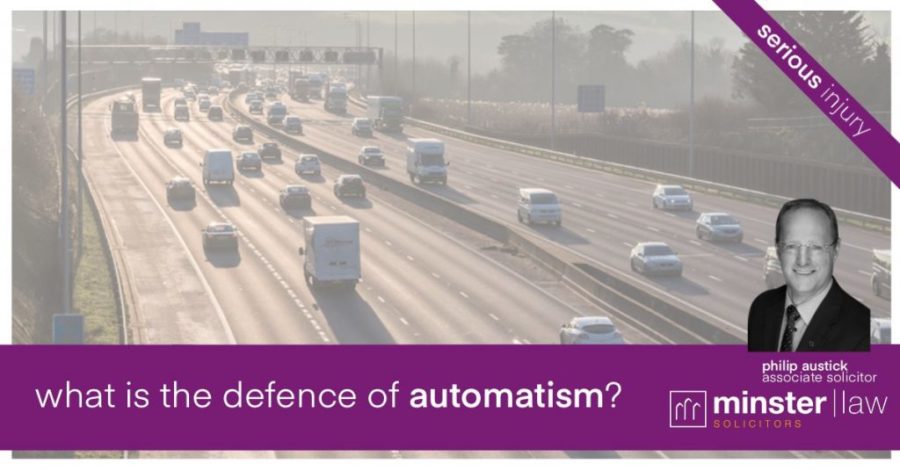What is a defence of Automatism and how do we counter that?


In recent times, an increasingly popular and frequently used argument to deny liability for an accident has emerged – the defence of automatism.
This is based on the allegation that a defendant was not consciously in control of his or her vehicle at the time of the collision.
Minster Law Associate Solicitor Philip Austick has successfully recovered £500,000 for a claimant involved in an accident, despite the defendant arguing that automatism is applied.
He shares how Minster has continued to adapt and find ways to ensure each of our clients receive the best possible outcome from their claim against this defence.
Avoiding responsibility for an accident by alleging you were in a state of automatism is an idea that has existed in both criminal and civil law for decades.
Automatism, in a legal setting, is the involuntary performance of action without that person making the conscious decision to act.
In most instances, it is caused by factors such as physical or mental illness.
When it comes to personal injury cases, automatism is essentially a defence that alleges that a person cannot be held legally responsible for the accident.
It claims at the time of the event, the otherwise responsible individual had suffered a sudden and total loss of control, rendering their actions involuntary, which could not have been anticipated, and which caused them to be a party to a horrible accident through no fault of their own.
An example of this may be a car driver who suffers a seizure or other medical episode, while behind the wheel, which causes them to suddenly and without warning become unconscious.
This argument has been raised by a number of insurers in an attempt to protect their clients from responsibility, but rarely has this defence succeeded.
This argument has been raised by a number of insurers in an attempt to protect their clients from responsibility, but rarely has this defence succeeded.
“We believe the reason for this is it is easy to say the accident was unexpected and unforeseeable, therefore the party had no control, in a way similar to the definition of automatism,” Philip said.
“However, fault in an accident cannot simply be considered in the context of just the event itself, such as the physical contact between cars or the impact on a person.”
Instead, Philip said, negligence in the events leading up to an accident could contribute to or even cause the episode leading to the accident.
For instance, if a driver has failed to take prescribed medication as recommended or drove contrary to the medical advice he has received which then leads to a medical episode occurring, or if there were warning signs which he or she has failed to respond to but simply continued driving, that person could carry some responsibility for the collision.
Ultimately if these earlier actions or omissions of the driver lead to them suffering a loss of consciousness and consequently cause them to lose control, it can be difficult to deny some degree of fault on the driver.
“In cases where the loss of control was entirely unforeseen, the basis of the Defence will rest on whether it was possible for the Defendant to have anticipated the apparent loss of consciousness in enough time so as to have avoided an accident,” Philip said.
“The length of time between the onset of the symptoms of illness and the occurrence of the loss of consciousness and consequent loss of control can be of crucial importance to the success of the defence.”
This period of time is referred to as the ‘prodrome’.
The prodrome of an illness or disease differs depending on the illness or disease and this differs on each individual case – it is most relevant in cases of spontaneous loss of consciousness or fainting.
A research paper, published in 2002, studied the prodrome of Vasovagal Syncope, otherwise known as fainting as a result of drop-in blood pressure or heart rate.
The paper was referred to in Green -v- Haynes as the ‘Alboni Paper’.
Their research found that 69% of patients studied suffered while standing, a prodrome of more than 10 seconds.
They argue that those seated, as you would be in a vehicle, tended to suffer a longer prodrome.
Also, in 2002, professors Miller and Kruse, found that prodromal symptoms of fainting could last from seconds to several minutes.
Philip said the question for the court would therefore be, ‘how long did that specific individual suffer symptoms for, prior to the loss of control, and would they have been able to prevent the accident from occurring?’
“If they did, it would be just to consider them liable.”
Generally, the courts are reluctant to make a finding of automatism unless the defendant is able to prove they have done nothing wrong and so could not have foreseen the possibility of such an event occurring.
“In such a case, it would be unjust to attach any degree of blame to them,” Philip said.
Unlike certain countries that operate a ‘no-fault compensation based system, domestic UK law requires an individual to prove some element of culpability or legal blame against the person who is being ordered to pay damages, even though such damages are normally covered by a policy of insurance.
The decision by the court in Green -v- Haynes in 2014 led to the court revisiting the law on automatism and considering, in particular, if it can ever be a complete Defence to a claim.
In that case, the Claimant Mr Green was stationary in his vehicle at a set of traffic lights, when the Defendant, Mr Haynes, who was driving a much larger and heavier vehicle, drove into the back of Mr Green’s vehicle, causing him very serious injury.
As it transpired Mr Haynes had felt unwell while at a conference he had been attending earlier in the day.
He had therefore chosen to leave shortly after arriving at the conference, driving home in the belief his condition could not get any worse.
On his way home he rang his wife, asking her to make him an emergency appointment with his GP, and it was on this drive home he drove into Mr Green’s vehicle, albeit unintentionally.
Judge Supperstone refused to accept the defence of automatism alleged by Mr Haynes and pointed out that Mr Haynes should not have driven when he knew how ill he was and knew, or ought to have known, this was likely to impair his judgement.
The Judge also found that Mr Haynes had been travelling in the faster outside lane, rather than the slower nearside lane, and had ignored the opportunity to avoid a collision or to minimise the damage he was likely to cause.
Finally, Judge Supperstone found, based on medical evidence, Mr Haynes’ prodrome was likely longer than the reported 2 to 3 seconds and he, therefore, would have had more time to act to avoid the incident than he submitted in his account.
Judge Supperstone concluded that, had Mr Haynes been driving in the inside lane at 55 mph, he would have had sufficient time to reach a halt before he blacked out.
As a result, judgment was awarded in the claimant’s favour.
The appeal case of Dunnage -v- Randall and UK Insurance Limited in 2015 also provides a very detailed analysis as to what it means to be involved in an automaton in an accident.
In this appeal case, Lady Justice Ardern, Lady Justice Rafferty and Lord Justice Vos deconstructed an incident that occurred while the defendant was suffering from schizophrenia.
The defendant had argued immediately prior to causing the harm to the Claimant, they were suffering a definite and distinguishable loss of control as a result of the symptoms of schizophrenia.
The Judges disagreed, distinguishing between what they considered to be a lack of rational choice and the definition of automatism, which is a lack of any choice.
He had physical control over his actions, even if his ability to rationalise was impaired by his condition.
The Claimant, in that case, was also awarded damages.
These cases help to demonstrate the hard line taken by the Courts when it comes to the Defence of automatism.
Automatism remains a legal Defence that can be raised by a Defendant in a personal injury claim and has been advanced by insurers as a means of avoiding all liability of a claimant’s claim.
Philip said, in the case of a road traffic collision where liability seems obvious, for instance where a driver has crossed onto the wrong side of the road and collided with another road user or even mounted a pavement striking a pedestrian, it’s possible to question if there’s any merit to this defence.
“In cases where the Defendant suffered an unexpected and total loss of control that could not be anticipated, it would be unjust to impose any blame on their part for the accident. However, their actions can ultimately lead to devastating consequences for Claimants and it is our obligation to thoroughly and properly investigate and test any allegation of automatism to see if it can is fairly be made out.”
It is not beyond the realms of common sense to say that accidents caused by an instance of automatism should be in the relative minority.
“However, in our experience, these allegations are raised in a disproportionate number of cases.
As a result, we are determined and focussed to acquire and examine evidence in order to tackle the overuse of this Defence,” Philip said.